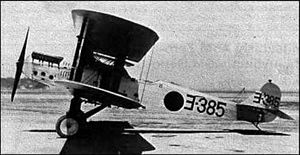Mitsubishi B1M
| B1M | |
|---|---|
 |
|
| Role | Torpedo bomber |
| Manufacturer | Mitsubishi |
| First flight | 1923 |
| Introduction | 1924 |
| Primary user | Imperial Japanese Navy |
| Number built | 443 |
| Variants | Mitsubishi 2MB1 |
The Mitsubishi B1M was a Japanese torpedo bomber of the 1920s, also known as the Navy Type 13 Carrier-Borne Attack Aircraft. It was designed and built by Mitsubishi and used in combat against China.
While working with the Mitsubishi company, the British aircraft designer Herbert Smith designed the 2MT1 two-seat biplane torpedo bomber which flew for the first time in January 1923. It went into Japanese Navy service as the Type 13-1 carrier-borne attack aircraft or B1M1, and was followed by the 2MT2 and 2MT3 variants (also designated B1M1). The redesigned Type 13-2 was designated B1M2. The final version, the Type 13-3 or B1M3, had the company designation 3MT2 and was a three-seater. Total production was 443. The B1M was powered by a 450 hp (340 kW) Napier Lion or Hispano-Suiza engine according to version.
The type entered service in 1924 and served into the 1930s, 32 flying from the aircraft carriers Kaga and Hōshō during the Shanghai Incident in 1932. An aircraft from Kaga was lost during an aerial engagement between an American air force adviser and demonstration pilot to the Chinese government, Robert Short, who also lost his life, and regarded as a hero defending the Chinese city against the Japanese aircraft.
From 1929, a number of surplus B1Ms were converted for civilian use, being fitted with an enclosed cabin for passengers or cargo.
Data from The Encyclopedia of World Aircraft
General characteristics
Performance
...
Wikipedia
